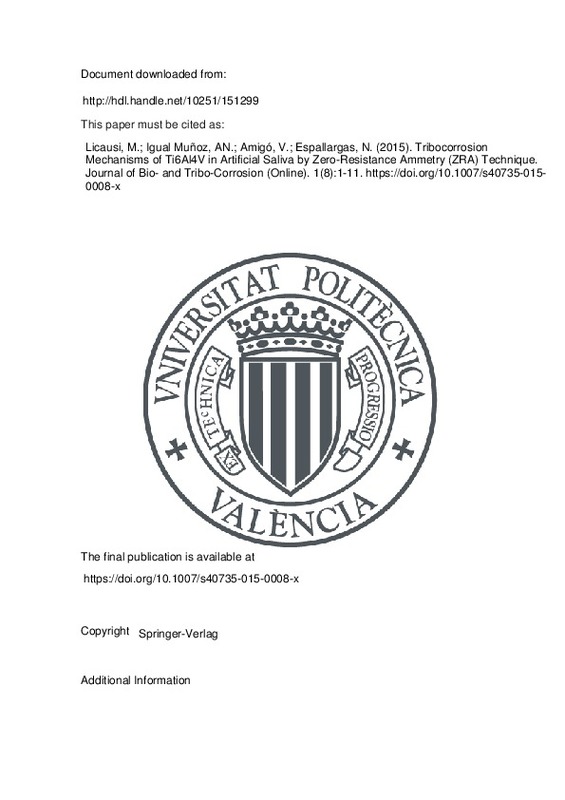Martin É, Azzi M, Salishchev GA, Szpunar J (2010) Influence of microstructure and texture on the corrosion and tribocorrosion behaviour of Ti–6Al–4V. Tribol Int 43:918–924
Nosonovsky M, Bhushan B (2010) Green tribology: principles, research areas and challenges. Philos Trans R Soc A 368:4677–4694
Geetha M, Singh AK, Asokamani R, Gogia AK (2009) Ti based biomaterials, the ultimate choice for orthopaedic implants—a review. Prog Mater Sci 54:397–425
[+]
Martin É, Azzi M, Salishchev GA, Szpunar J (2010) Influence of microstructure and texture on the corrosion and tribocorrosion behaviour of Ti–6Al–4V. Tribol Int 43:918–924
Nosonovsky M, Bhushan B (2010) Green tribology: principles, research areas and challenges. Philos Trans R Soc A 368:4677–4694
Geetha M, Singh AK, Asokamani R, Gogia AK (2009) Ti based biomaterials, the ultimate choice for orthopaedic implants—a review. Prog Mater Sci 54:397–425
Niinomi M, Kuroda D, Fukunaga K, Morinaga M, Kato Y, Yashiro T et al (1999) Corrosion wear fracture of new β type biomedical titanium alloys. Mater Sci Eng A 263:193–199
Kuroda D, Niinomi M, Morinaga M, Kato Y, Yashiro T (1998) Design and mechanical properties of new β type titanium alloys for implant materials. Mater Sci Eng A 243:244–249
Eisenbarth E, Velten D, Müller M, Thull R, Breme J (2004) Biocompatibility of β-stabilizing elements of titanium alloys. Biomaterials 25:5705–5713
More NS, Diomidis N, Paul SN, Roy M, Mischler S (2011) Tribocorrosion behaviour of β titanium alloys in physiological solutions containing synovial components. Mater Sci Eng C 31:400–408
Milošev I, Metikoš-Huković M, Strehblow H-H (2000) Passive film on orthopaedic TiAlV alloy formed in physiological solution investigated by X-ray photoelectron spectroscopy. Biomaterials 21:2103–2113
Komotori J, Hisamori N, Ohmori Y (2007) The corrosion/wear mechanisms of Ti–6Al–4V alloy for different scratching rates. Wear 263:412–418
Dimah MK, Devesa Albeza F, Amigó Borrás V, Igual Muñoz A (2012) Study of the biotribocorrosion behaviour of titanium biomedical alloys in simulated body fluids by electrochemical techniques. Wear 294–295:409–418
Licausi MP, Igual Muñoz A, Amigó Borrás V (2013) Tribocorrosion mechanisms of Ti6Al4V biomedical alloys in artificial saliva with different pHs. J Phys D 46:404003
Runa MJ, Mathew MT, Rocha LA (2013) Tribocorrosion response of the Ti6Al4V alloys commonly used in femoral stems. Tribol Int 68:85–93
Munoz AI, Espallargas N (2011) Tribocorrosion mechanisms in sliding contacts. In: Landolt D, Mischler S (eds) Tribocorrosion of passive metals and coatings. Woodhead Publishing, Lausanne
Mischler S (2008) Triboelectrochemical techniques and interpretation methods in tribocorrosion: a comparative evaluation. Tribol Int 41:573–583
Espallargas N, Johnsen R, Torres C, Muñoz AI (2013) A new experimental technique for quantifying the galvanic coupling effects on stainless steel during tribocorrosion under equilibrium conditions. Wear 307:190–197
Vieira AC, Rocha LA, Papageorgiou N, Mischler S (2012) Mechanical and electrochemical deterioration mechanisms in the tribocorrosion of Al alloys in NaCl and in NaNO3 solutions. Corros Sci 54:26–35
Papageorgiou N, Mischler S (2012) Electrochemical simulation of the current and potential response in sliding tribocorrosion. Tribol Lett 48(3):271–283
Papageorgiou N, von Bonin A, Espallargas N (2014) Tribocorrosion mechanisms of NiCrMo-625 alloy: an electrochemical modeling approach. Tribol Int 73:177–186
Dearnley PA, Dahm KL, Çimenoglu H (2004) The corrosion-wear behaviour of thermally oxidised CP-Ti and Ti-6Al-4V. Wear 256:469–479
[-]







![[Cerrado]](/themes/UPV/images/candado.png)


